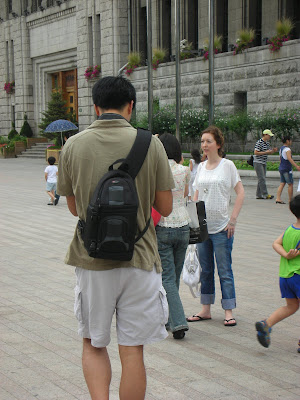Sunday, August 26, 2007
asia's gambling resort destination, macau, a former portuguese colony, is booming with construction and development. hotelier, casino mogul, and avid art collector , steve wynn has a franchise there, just down the road from a sands/venetian. the new york times discusses macau's vice boom in an article entitled: bigger than las vegas, that's macao's bet. clever.
but before all of these modern casinos were built, there was hotel lisboa, an eclectic and gaudy signature development on macau's strip.
of course, the newer casino hotels have the benefit of incorporating the newest technological innovations and can offer the most luxurious amenities. and yet, still, hotel lisboa stands alone as an original, at least in one respect: the bathrooms.
the beautiful nude on the wall is not the only design element to employ a faux bas relief aesthetic. at the urinal, while you stand on stainless steel nodes, you remain poised above the purge as the floor flushes around you. we are unsure if this has any actual public/personal health benefits of it it's all just for show.
Thursday, August 23, 2007
months into a deep cover assignment and only days away from breaking the story of 2007, seoulitary confinment's reporters have been outed!
posing as a tourist couple, one of our reporting teams was preparing an expose on the child labor practices of korean cultural event performance troupes. one particularly egregious violator was performing in seoul's city hall park - using the auspices of glorious korean tradition to exploit child labor. our crack team was busily snapping photos and mingling with some of the teen and pre-teen performers during a brief respite from the rigors of their abusive schedule. for example, the traditional korean mask pictured here is as grotesque as it is constricting. not only are these facades disturbingly ugly, but they also obstruct airflow.
these drums are piercingly loud. notice our reporter's cringe. with decibel levels like this, these poor children should all be wearing ear-plugs or some alternative form of cochlear protection.
having secured interviews and photographic evidence, the reporters were days away from taking the story to press, that is, until a competing news organization, the daily kimchi, ran photos of our reporters hard at work, exposing them and destroying the critically important guise of anonymity.
this is not seoulitary confinement's first encounter with the daily kimchi, but it is the most serendipitous. in an earlier confrontation, gdog at the daily responded to some unduly harsh criticism. read it here. and gdog's response.
by sheer numbers, the daily kimchi is (was?) one of seoul's most popular expatriate blogs, and merits high marks for its highly informative, exceptionally consistent posts and stellar photography. our reporters knew they were watching a master in the midst of his craft and sensing the propitious moment, snapped a picture. we should have said, "HOLLA." gdog and devante, your contributions will be missed. godspeed.
posing as a tourist couple, one of our reporting teams was preparing an expose on the child labor practices of korean cultural event performance troupes. one particularly egregious violator was performing in seoul's city hall park - using the auspices of glorious korean tradition to exploit child labor. our crack team was busily snapping photos and mingling with some of the teen and pre-teen performers during a brief respite from the rigors of their abusive schedule. for example, the traditional korean mask pictured here is as grotesque as it is constricting. not only are these facades disturbingly ugly, but they also obstruct airflow.
these drums are piercingly loud. notice our reporter's cringe. with decibel levels like this, these poor children should all be wearing ear-plugs or some alternative form of cochlear protection.
having secured interviews and photographic evidence, the reporters were days away from taking the story to press, that is, until a competing news organization, the daily kimchi, ran photos of our reporters hard at work, exposing them and destroying the critically important guise of anonymity.
Seoul City Hall: Always Something To See
A group of people were doing some sort of cultural dance with costumes and the whole nine yards. After they finished, they left their equipment neatly laid out to take a break. Then, right after some people came by to take pictures—but they started putting on the masks! I don’t know if that was normal or not, but I should’ve joined in on the fun! Check out this couple:
I should've put this mask on
this is not seoulitary confinement's first encounter with the daily kimchi, but it is the most serendipitous. in an earlier confrontation, gdog at the daily responded to some unduly harsh criticism. read it here. and gdog's response.
by sheer numbers, the daily kimchi is (was?) one of seoul's most popular expatriate blogs, and merits high marks for its highly informative, exceptionally consistent posts and stellar photography. our reporters knew they were watching a master in the midst of his craft and sensing the propitious moment, snapped a picture. we should have said, "HOLLA." gdog and devante, your contributions will be missed. godspeed.
Wednesday, August 22, 2007
in agrarian societies, skin tone is a primary basis by which the culture delineates social status- the darker the skin, the more exposure to the sun from field labor, less time for education, fewer resources and leisure. this is much too simple an analysis for today's complex, dynamic, and globalized societies, but cultural norms ingrained over thousands of years and many generations are not quick to wane. the boston globe's vanessa e. jones wrote a much more thorough, but by no means exhaustive, report in 2004: Pride or prejudice? A formally taboo topic among Asian-Americans and Latinos comes out into the open as skin tone consciousness sparks a backlash
though the article makes no specific mention of korea, it does address the philippines. a december assignment to manila sent seoulitary confinement's reporters right into the fray, to a town where fair skin begets celebrity and every bar of soap holds the promise of washing the dark away.
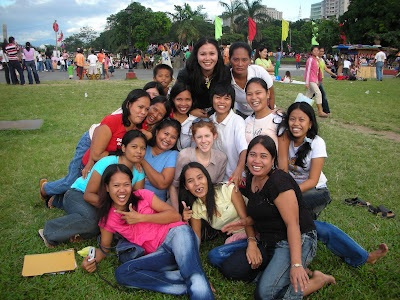

in korea, the war against melanin manifests in different ways, but is no less intense. whitening creams, 화이트닝 크림 (hwa-ee-tuh-ning kuh-reem), populate store shelves and pervade the beauty supply marketplace. a quick search through korea's web portal naver.com yields a plethora of ads for various creams, powders, and salves.
the results also include a link to a korea herald article: Beauty industry targets Asian women`s obsession with white skin
at the dongdaemun (east gate) market, the artificial whitening trend has reached the height of absurdity.

though the article makes no specific mention of korea, it does address the philippines. a december assignment to manila sent seoulitary confinement's reporters right into the fray, to a town where fair skin begets celebrity and every bar of soap holds the promise of washing the dark away.


in korea, the war against melanin manifests in different ways, but is no less intense. whitening creams, 화이트닝 크림 (hwa-ee-tuh-ning kuh-reem), populate store shelves and pervade the beauty supply marketplace. a quick search through korea's web portal naver.com yields a plethora of ads for various creams, powders, and salves.
the results also include a link to a korea herald article: Beauty industry targets Asian women`s obsession with white skin
Cosmetics companies will have us believe that there is hope in a jar.
After spending millions on independent and commissioned research, major cosmetics brands woo customers each season with their latest and best-to-date products.
This season it is the Asian women`s fixation with flawless, "white" skin that the beauty industry is focusing on. International as well as domestic brands have developed "whitening" or "brightening" products that claim to make the complexion as pure as snow.
at the dongdaemun (east gate) market, the artificial whitening trend has reached the height of absurdity.

Subscribe to:
Posts (Atom)
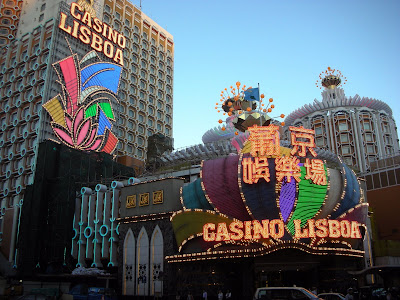
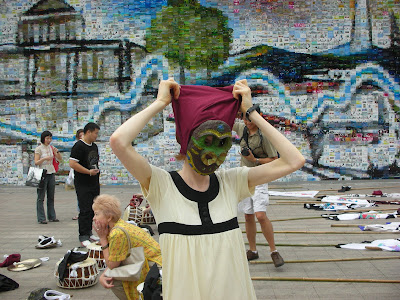
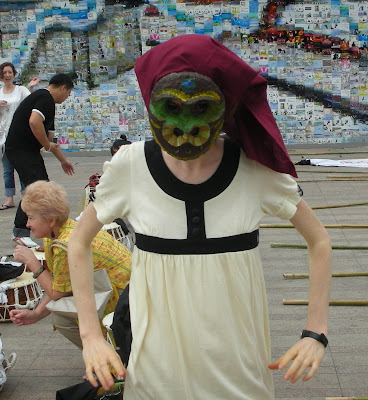

.JPG)


